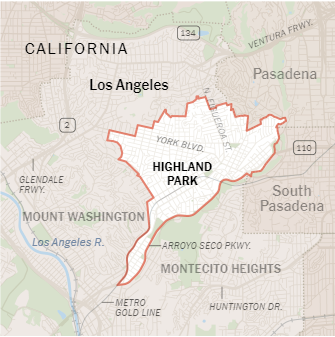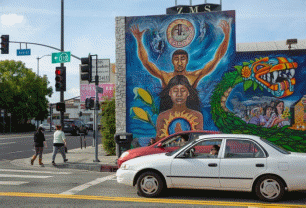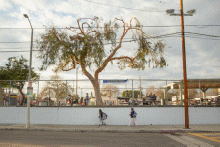Introduction
Historical decisions and policies of the United States and Los Angeles have led to the uneven development of its neighborhoods, which is especially noticeable today. Famous areas such as Pacific Palisades, Hollywood, Beverly Glen, and Beverly Hills have theaters, restaurants, hospitals, schools, and malls that satisfy the needs of any person. Thus, real estate in these areas has high prices according to its convenience and features.
Other areas, such as South Los Angeles, face overcrowding, poor housing conditions, and remoteness from essential infrastructure but have cheap rent and houses. However, the gentrification process has also led to creating neighborhoods in transition, where architecture and infrastructure are being updated, and property prices rise. At the same time, many residents of such areas are forced to move due to an increase in rent for their housing, which they cannot afford.
One such area is Highland Park, which has become a popular area for gentrification due to its favorable geographic location and cheap property prices. However, news of recent years has shown that the neighborhood’s architectural features have become one of the important incentives for residents of Highland Park to resist gentrification. For this reason, this paper will examine the geographic and architectural features of Highland Park to examine their impact on the anti-gentrification protests and social tensions they have caused.
Geographical and Social Features of Highland Park
Highland Park is located in Northeast Los Angeles and has initially been its first suburb, although it is not far from the center. This area is usually referred to as the East Side both because of its location and due to the historical composition of the population (Fig.1). Hispanics, Latinox, and African Americans who could not buy or rent a house in the “white areas” were allowed to settle in these territories (Guzman 13). Highland Park is bordered by Highway 110 and the Eagle Rock and Pasadena neighborhoods and has the LA Metro Gold Line, from which anyone can reach the city center in 35 minutes (Kamin). This location is convenient for most residents who cannot afford housing in the central areas.

Another feature of Highland Park is its historicity and diversity of architecture. In 2010, the Garvanza area was added to the territory of the neighborhood, and today Highland Park-Garvanza encompasses approximately 4,000 structures from the 1880s to 1940s (“Highland Park – Garvanza”). Consequently, while some of these buildings are protected by law as historical monuments, others are attractive for people who want a unique home for life or business. At the same time, residential buildings are also comfortable and practical, although they often require renovation, which makes them valuable for buyers and tenants.
The convenient planning of Highland Park also allows residents to freely move around the streets on foot or use personal and public transport. This feature makes the neighborhood convenient for tourists to visit, create attractions, and open restaurants.
An essential aspect for understanding the geography of an area is its population. Most of the inhabitants are Latino people (72,4%), while the percentage of the white population began to increase only in the 2000s, along with the gentrification processes (“Highland Park”). In addition, the inhabitants of this area are mainly workers and artists with a low level of income, since the cost of renting and buying houses is several times lower than in the central or coastal areas. For example, in 2019, single-family homes’ average price was $829,000 (Kamin). However, over the past decades, this value has also increased several times, which gradually began to affect the composition of the population.
However, the main feature of Highland Park is the murals that cover the neighborhood’s walls. Most of them were created in the early 2000s and are of particular cultural value for the residents of the neighborhood. Highland Park is predominantly inhabited by Latino people, who moved to this neighborhood mostly in the 1970s and 1980s, since this area was neglected and cheap. For this reason, murals reflect the cultural values and beliefs of the local population. For example, one of the most famous murals was the image of an Aztec warrior (Gumbel, “‘Whitewashed’”). Other examples of similar murals are depictions of migrant workers, indigenous peoples of Canada, America, and Mexico, or folklore stories (Fig.2.). Such murals are the adornment of the neighborhood and the pride of locals who honor their culture and traditions.

Reasons for Gentrifications
Highland Park is not the only Los Angeles neighborhood going through a gentrification process. Other areas, such as Boyle Heights, Silver Lake, and Eagle Rock, have also become targets for renewal; however, Highland Park has several advantages. Firstly, this neighborhood lies between the central districts and Pasadena and has access to the highway, which allows residents to quickly get to work or entertainment in the central area or Westside. In addition, the Golden Metro Line that connects Highland Park and the city center makes travel easy and comfortable for tourists. Downtown residents will also have easy access to Highland Park to visit some of the neighborhood’s unique and historic sites.
Secondly, Highland Park is built in such a way that it allows people to walk the streets and places with active traffic, which is not available to Boyle Heights, through which three highways pass. The historic architecture and murals in Highland Park’s streets also create a distinct ambiance and creative vibes that locals and tourists like. For this reason, it is profitable for business owners to buy and renovate Highland Park houses to replace the old stores with trendy coffee shops and restaurants that will attract visitors. In addition, low property prices is a typical non-geographic reason for gentrification; however, this fact applies to all areas. Thus, while the main reason for gentrification is usually the cheap cost of real estate, Highland Park is a favorable neighborhood for modernization because of its convenient location and architectural features.
Anti-gentrification Protests as Social Tension of Highland Park Neighborhood
A feature of the gentrification of Highland Park and other areas of the East Side is that most residents perceive them as a process of displacing people of color. More than 70% of the Highland Park population are Latino people who have low income, and gentrification forces many of them to leave their houses as their landlords increase their rent several times (Madans; Gumbel, “L.A.’s Hottest Neighborhood”).
Families are forced to move to remote areas on the outskirts with more affordable housing and travel several hours to their workplace. At the same time, even those residents who own their houses do not always benefit from new “hipster” restaurants because they often cannot afford a $5 coffee but have to pay higher property taxes. Consequently, the majority of Highland Park residents protest against gentrification, and their aggression is directed against the “white hipsters”, since predominantly white buy their houses (Gumbel, “L.A.’s Hottest Neighborhood”). Simultaneously, this aggression causes a reaction among the new residents of the area, which creates tension and racial conflicts.
At the same time, some studies explore the process of the East Side gentrification and conclude that this process is not just a desire to modernize the city but whitening projects. For example, Guzmán claims that racial displacement is not separate from gentrification and that its primary goal is to prepare neighborhoods for white families. Although this statement can be argued and overcome in some matters, general tendencies of people of color displacement and protests in Highland part, in particular, confirms it.
Another similarity of Highland Park tension and researches findings is the manifestation of protests. Highland Park’s anti-gentrification movement’s peculiarity is that it rarely causes direct confrontation, but people express their disagreements through art and street signs. For example, people of Highland Park neighborhood ruin new murals made by “hipsters” and create new ones with a specific context against gentrification, and renovate culturally important street art that was whitewashed (Gumbel, “‘Whitewashed’”). The same methods were used by the inhabitants of Pilsen Hispanic District, Chicago, to collectively resist economic and racial oppression through its art (Luiggi). Therefore, the peculiarity of tension in Highland Park is that the architecture and geographic locations are its cause and weapon at the same time.
Influence of Murals on Social Tension
While many authors’ researches demonstrate that gentrification is socially and racially unjust, many of its supporters can deny this fact. Unlike Crow’s law, which prohibited people of color from settling in certain areas, gentrification does not officially imply action against non-white races or ethics. For this reason, most governments encourage gentrification as it brings development and tax revenue to their cities.
However, more often, the authorities do not take into account the interests of people who are forced to leave their homes due to the renewal of their neighborhoods. Consequently, Highland Park residents may claim racial and social injustice but not always can provide evidence. Nevertheless, the destruction and whitewashing of murals, which have historical and cultural significance to the neighborhood, are compelling reasons for the protests.
An examination of Highland Park murals, which have been whitewashed or may soon be erased, demonstrates that their destruction implies political nature. For example, John “Zender” Estrada’s mural of an Aztec warrior flanked by two eagles was whitewashed after purchasing the building (Gumbel, “‘Whitewashed’”). Other murals created by famous local artists were also replaced with something more politically neutral than depicting controversial issues of migration or Native Americans or turned into advertisements. At the same time, Los Angeles has a 2013 law that protects murals of historical and cultural value; nevertheless, the whitewashing continues (Gumbel, “‘Whitewashed’”).
For example, the mural Tenochtitlan, created by nine artists, is under threat of destruction, as the new owners of the building want to make two windows in it (Gumbel, “‘Whitewashed’”). Thus, although murals are formally protected by law, the gentrification processes and the need to change the buildings lead to the removal of historical monuments. Consequently, a significant part of Highland Park residents opposes the creation of new expensive cafes and restaurants, since this means for them not only an increase in rent but the destruction of their culture and feature of the neighborhood.

Moreover, while the deliberate erasure of murals that carry political and ethnic context is difficult to prove, Highland Park residents often perceive such change as an attempt to drive Latino people out of their neighborhoods. Such beliefs are generally logical, since most of the murals are the work of professional artists and street decorations. Hence, these artworks should attract visitors who have a healthy attitude to the US population’s diversity.
Consequently, people can conclude that murals and graffiti have political implications and signs of attempts to displace people of color from Highland Park. This fact is confirmed by the word “Displacers”, which someone wrote over the mural, which replaced the Frank Romero-esque heart (Gumbel, “‘Whitewashed’”). Thus, whitewashing murals in Highland Park and spoiling their replacements are symbols of tensions that have racial nature. Locals resist changes in rental prices and injustice caused by erasing their culture from the historic Los Angeles neighborhood.
Conclusion
The main problem and social tension of the Highland Park Neighborhood in recent years have been the gentrification of the area. This issue has created latent racial conflict and tensions between old and new residents and new business owners in the neighborhood. Although the influence of geographic reasons and the architecture of the area is not evident at first glance, they have great significance in the initiation and development of the conflict.
First, the geographic features of Highland Park, together with its architecture and cheap real estate, make it an advantageous area for gentrification. Highland Park is located near the center, has highway access, and is connected by the subway, which makes it convenient for locals and tourists. At the same time, some of the neighborhood’s architecture is of historical importance, and the Highland Park development plan creates a unique atmosphere for walking and relaxing. In addition, the low-cost real estate and creative vibes of Highland Park make the neighborhood attractive for business people and artists looking to open their restaurant or art gallery.
However, the main feature of Highland Park is the murals, which have historical and cultural importance to most of the neighborhood’s residents. These murals and street art most often depict the stories and myths of the indigenous people of the Americas and its tribes, the ancient civilization of the Aztecs and Incas, or migrants. Since most of the neighborhood’s residents are Latino people, they perceive these murals as part of their Highland Park affiliation because they relate to their cultural part of identity. For this reason, mural whitewashing, which is the result of gentrification, is a motive for many locals to oppose these changes.
The fight against the modernization of the area and for the preservation of murals for many of the residents of Highland Park is also an opposition to racial injustice, since Latino families are primary victims of Highland Park gentrification. These families are displaced from their homes to the city’s outskirts because they cannot afford the rent available to potential white tenants. For this reason, as part of Highland Park architecture, murals are an opportunity and a means of highlighting the injustice of gentrification as the process of moving people of color out of their homes.
Works Cited
Gumbel, Andrew. “L.A.’s Hottest Neighborhood is Where the City’s Existential Crises Have Come Home to Roost.” Los Angeleno.2020. Web.
Gumbel, Andrew. “‘Whitewashed’: How Gentrification Continues to Erase LA’s Bold Murals.” The Guardian. 2020. Web.
Guzman, Jaime. The Whiteness Project of Gentrification: The Battle over Los Angeles’ Eastside. 2018. PhD Dissertation. Electronic Theses and Dissertations.
“Highland Park – Garvanza Historic Preservation Overlay Zone.” Los Angeles City Planning. Web.
“Highland Park”. Los Angeles Times. Web.
Kamin, Debra. “Highland Park, Los Angeles: A Watchful Eye on Gentrification.” The New York Times. 2019. Web.
Luiggi, Christina. “Who Have You Displaced Today?”: “Haciendo Caras” as Collective Resistance against Gentrification en Pilsen Hispanic District, Chicago. Ray Browne Conference on Cultural and Critical Studies, 2018. Web.
Madans, Hannah. “Hip Hooray: Highland Park Has History — and Property Prices — on Its Side.” Los Angeles Business Journal. 2020. Web.